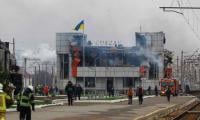LAHORE : Population explosion and climate change are the big challenges Pakistan is facing. These challenges are denting efforts to maintain balance between population and resources.
The high growth rate of population and climate change form a deadly combination, which leads to increased strain on resources, environmental degradation, heightened risk of natural disasters stagflation and poverty. “Pakistan, first, needs to recognise the elephant in the room and take action to prevent the combo from unleashing more destruction, which further takes resources away from, now, mostly underprivileged population in the country,” warned population and environmental experts.
According to the World Climatological Database, average temperature recorded in Pakistan between 1980 and 2021 increased by about 0.9 degrees centigrade. While Pakistan produces less than 1% of the global carbon emissions, Global Climate Risk Index ranks Pakistan 5th most climate-vulnerable and ND-Gain Index ranks it as 27th least ready country in the world to address the impacts of climate change. Pakistan has lost nearly 10,000 lives and has suffered economic losses worth $3.8 billion due to climate change from 1998 to 2018, while the recent floods in 2022 further cost life, infrastructure and economic losses of over USD 30 billion and reconstruction needs over USD 16 billion. The Post-Disaster Needs Assessment (PDNA) Human Impact Assessment highlights that the national poverty rate may increase by 3.7 to 4.0 percentage points, potentially pushing between 8.4 and 9.1 million more people below the poverty line in Pakistan.
The latest census has recorded Pakistan’s total population at 241.5 million as of 2023, which it as the 5th most populous country in the world. With current average annual growth rate of 2.55% (2017-2023), Pakistan will require 104 million jobs and 15.5 million houses. On top of it, the climate change as a result of rising temperatures are disrupting rainfall patterns, melting glaciers, intensifying floods, drought and sea incursion to cause extreme weather events, thus, further exacerbating the economic disparities and vulnerabilities.
Prof Zulfiqar Ali, an environmental expert, says the el nino and la nino effects on regional weather pattern trigger extreme heatwave and cold wave, which is likely to persist till 2027. He said the current hot weather is extremely harmful for human, livestock and plant health alike, which may affect each of these interdependent species in more ways than one.
“Pakistan has turned from net exporter of wheat to net importer of wheat in a short period of just five years, thanks to formidable twin challenge of climate change and population explosion effecting in tandem,” says Mushtaq Ahmad Gill, Chief Executive, South Asian Conservation Agriculture Network (SACAN).
“Half of the year, we face drought, the other half, floods,” Gill, who is also former Director General of Water Management, Punjab, and called for increasing water storage and save precious water worth billions of dollars from going into the sea every year.
According to World Development Indicators, World Bank Database 2023, in 2020, Total Fertility Rate (TFR – average number of children a woman has during her reproductive age) in Pakistan is highest i.e. 3.6 in South Asia, followed by 2.0 in Bangladesh, 2.2 in Indonesia, and 1.9 in Turkiye.
The Population Council Pakistan suggests, with current population size and growth rate, Pakistan needs at least 57,000 more primary schools by 2040. While one out of three children (27pc boys and 37pc girls) is already out of school, Pakistan is unlikely to achieve Universal Primary Education until 2075.
The Population Council Project Director Samia Ali says, at least 11,000 maternal deaths occur annually in Pakistan, and as many as 62 infants per 1000 live births die before reaching 1 year of age. If contraceptive use rises from the current 34pc to 52pc, as many as 3,800 mothers 140,000 infants can be saved.
She says the high fertility exacerbates food insecurity and malnutrition, which results in children under the age of 5 to be 40pc stunted, 18pc wasted, and 29pc underweight. According to National Nutrition Survey 2018, a total of 36.9pc households are food insecure in Pakistan.
“Every additional person increases carbon emissions – the rich far more than the poor – and increases the number of climate change victims – the poor far more than the rich,” Samia Ali opined.
Ahmad Rafay Alam, renowned environmental advocate, said that the global warming has increased the temperature by 1.2°C in the world, but its impact is significantly higher in Pakistan with estimated increase of 2.5°C in temperature since 1960.
“For every degree increase, there’s loss of 10 percent of crop productivity.” he said, and advised not to create environmental heat through stubble burning. To reduce pressure on wheat production, he believes people must go back to traditional cereal foods like pearl millet, barley, maize, etc.
The environmentalists and agriculture experts say the higher temperatures during growing seasons lead to faster crop maturation, adversely affecting agricultural productivity and rising food insecurity.
Dr Ali Mir, a population and demographic expert, says, the rapidly-growing population has substantially impacted deforestation and the loss of green spaces, as Pakistan lost 1pc tree cover from 2001 to 2021. Similarly, the increasing population has caused the intrusion of agricultural land to meet increasing housing needs as Pakistan’s arable land fell by 3pc between 2017 and 2020. The uncontrolled urban sprawl is also a factor in the rise in city temperatures. For instance, the use of air conditioners is one of the primary sources of producing dry heat. From 2004-2005 to 2019-20, the percentage of households using air conditioners climbed from 8pc to 13.5pc in urban areas and from 3.1pc to 6.7pc in rural parts.
While Pakistan’s current public sector spending is less than $1.0 per capita, the experts emphasized the need to increase spending on population services. The climate change discourse in Pakistan predominantly focused on mitigation strategies, which overlooked population growth, and dynamics in adaptation and resilience to climate changes.
With a view to effectively preventing the disastrous outcomes of climate change phenomenon and a sizeable population in tandem, Pakistan must adopt both mitigation and adaptation strategies by converting to green energy sources and lowering fertility rate respectively, which will help create a balance between people and resources in order to ensure survival and prosperity of the present and future generations.















